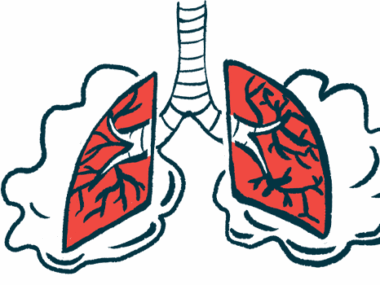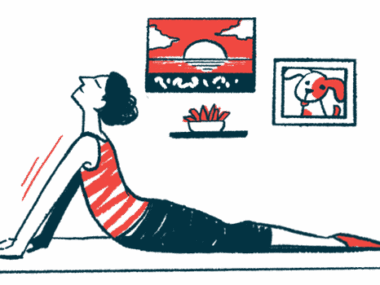How respiratory muscle strength training can benefit COPD patients
Keeping our lungs strong and healthy can help reduce shortness of breath
Written by |

Chronic obstructive pulmonary disease (COPD) makes it hard to breathe, and many of us with the disease know that breathing exercises can help. Still, a study published in October in Chronic Obstructive Pulmonary Diseases: Journal of the COPD Foundation suggested that a combined inspiratory (inhalation) and expiratory (exhalation) muscle strength training device can help strengthen the muscles that aid in breathing.
The authors noted that “few studies have evaluated the combined use of combined [inspiratory and expiratory muscle strength training] in COPD.” While more research is needed, the findings indicated that this combined program could potentially improve dyspnea, or shortness of breath.
The study doesn’t note which devices were used, but I’ve used two breathing trainers: the Portex Acapella and the Breather.
Before I began researching for this column, I didn’t consider the Acapella a breathing trainer. I saw it as a device to help bring up mucus, as it was prescribed to me in November when I had pneumonia.
The Breather is an exercise trainer designed to help strengthen the lungs. I used it for about a month and thought I saw some improvement in my breathing, but I grew tired of it. This new research prompted me to start using it again.
Causes of breathlessness in COPD
While respiratory muscle weakness can contribute to breathlessness in COPD, many other factors can cause dyspnea, including oxidative stress, respiratory overload, lung hyperinflation, peripheral muscle dysfunction, and declines in lung function.
Because exercise can induce shortness of breath, many people with COPD avoid physical activity. However, that choice can result in muscle deconditioning, which can make it harder to breathe.
One possible cause of oxidative stress is smoking, which can cause lung inflammation and damage to the alveoli (the air sacs in the lungs). Because the exchange of oxygen and carbon dioxide occurs in the alveoli, damage to these sacs can lead to breathing difficulty. Moreover, lung inflammation can cause hyperinflation, which often makes it painful to bend over and do various forms of exercise. As noted above, lack of exercise can further contribute to dyspnea.
In addition to physical deconditioning, poor nutrition can also lead to muscle loss. Therefore, eating a healthy, balanced diet is important for maintaining muscle strength.
Solutions
While a respiratory muscle strength training device can be a helpful tool, there are other ways to improve lung health and strength.
One of the most important things a person can do to improve their lung health is to quit smoking, though I know it’s far easier said than done. I tried many times to quit, but was never able to do so until I ended up in the hospital with a collapsed lung. Not being able to take a deep breath scared me right into quitting, and nicotine patches helped.
Another important tool is pulmonary rehabilitation. Both smoking cessation and pulmonary rehab have been shown to decrease mortality risk, allowing people to live longer.
Another benefit of pulmonary rehab is that you learn a lot about lung health. The program can help you develop an action plan so that you know when it’s time to seek medical treatment. I never knew when to go to the doctor for my symptoms until I developed my action plan.
It’s also important to continue being active after your pulmonary rehab sessions have ended. Exercising our inspiratory and expiratory muscles is crucial.
Speak with your clinician about how you can strengthen your lungs, and ask if respiratory muscle training is right for you. I’ll continue to use my breathing devices and hope for satisfactory results.
Note: COPD News Today is strictly a news and information website about the disease. It does not provide medical advice, diagnosis, or treatment. This content is not intended to be a substitute for professional medical advice, diagnosis, or treatment. Always seek the advice of your physician or other qualified health provider with any questions you may have regarding a medical condition. Never disregard professional medical advice or delay in seeking it because of something you have read on this website. The opinions expressed in this column are not those of COPD News Today or its parent company, Bionews, and are intended to spark discussion about issues pertaining to chronic obstructive pulmonary disease.







Njb
What is a "Breather"? Never heard of that. Where do I find one? Do I have to have a prescription?
RJF1
The Breather is available from PNMEDICAL.COM. I’ve been using it for five years. Great device.
David A Sylvester
Another great column Caroline. I experienced the same thing with my breathing devices--I used them and grew tired of using them. I'm going to get back to using the devices. I always have to remember that progress can be slow sometimes and we don't get instant results all the time. Thanks for the reminder
Fran Purser
I purchased the PEP Buddy Device last summer after seeing a couple of youtube videos put out by the physician developers from Cleveland Clinic. The PEP Buddy device was developed for mindful breathing and stress reduction as well as assisting with positive expiratory pressure breathing for copd, emphysema and lung diseases. (Disclaimer: I am not affiliated with this device except as an impressed and happy customer but I may sound like I am about to launch in to one of those stupid social media ads that are endless and mindless and steal your life in 45 minute segments whole hyping something expensive, subscription based and unlikely to help with what ever click bait issue they used to grab your attention.)
After using the PEP Buddy for about a week, I noticed that I was able to control & relieve my level of stress and after about four weeks, this device was helping me to practice this breathing method habitually.
The PEP Buddy is a small device that you hold between your lips that slows/restricts exhalation. (Inhale through nose and exhale through device.)
I use it when ozone levels rise which I have found make my breathing more labored. I use it when stressed for any reason and when going about daily chores and routines (watching tv, reading, walking my dog, etc.) I found that I had much less need for my rescue inhaler and after less than a month, often didn't need it for entire days. To me, this is remarkable. I took it to my PCP and he was impressed with both the common sense lung exercise aspect and the relatively inexpensive price point ($29.99). Order directly from www.pepbuddy.com
It is not available from Amazon, Walmart, etc.
Virginia Douglas
Hello the information was very informative. I have Zephyr valves procedure 2 in right lung and 1 in left lung. I have a team of pulmonary doctors. Anxiety and exacerbate is a problem for me.
Eva Gyllo
Since Jan 2021 I’ve been doing breathing exercising using a device called Airofit. I use it every evening (more or less and not on holidays 😂), and I have improved my lung function and volume quite a lot. I was diagnosed with COPD about 25 yrs ago. This device has helped me tremendously especially controlling my breathing, my capacity for holding my breath (after inhale/exhale) which in turn has helped me at the gym as well as every day activities.
Shahideen Jr
This article in particular is most useful, because as a stage 4 COPD patient, it motivates me to keep on working and researching ways to treat myself .
Looking forward to hear more new info in future.
Regards
Robert Tentua
Like to read when they find a medication to improve lungemfyseem
Phyllis Greenberg
I use the breather and it is very helpful . I like it it helps me breathe better
Ann Butler
I've just brought a revitive aerosure device and I'm finding it is helping me it's only been 2 weeks I can't wait for week I will let you know how I get on with it stay strong all Ann butler
Ann Butler
Hi Caroline firstly thank you very much for being there for us all you are like a breath of fresh air 😀 here in England 🏴 we really don't get much help so reading your column helps me alot I now also have a breathing gadget I tried to get a delta v no luck but I got one that has 1 to 7 7 making it harder 1 easier i also got a insensitive sipro I will start training this week let you know how I get on it makes sense what you say I need to strengthen my 🫁 first then hopefully I can exercise the rest of my body keep up the good work you inspire me Ann butler